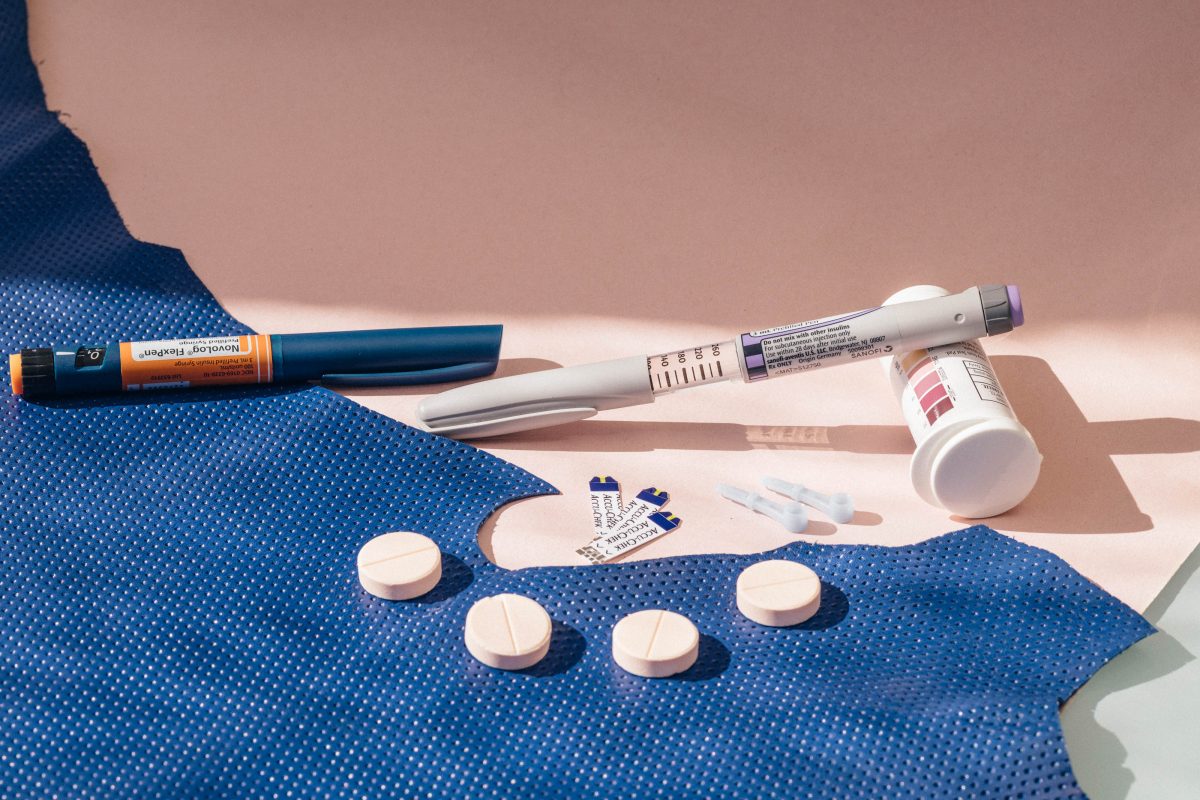

Living with Diabetes April 25, 2019
My Chronic Illness Totally Changed How I Think About Mental Health
by LARKIN
After 25 years with type 1 diabetes, I’ve learned that living with a chronic illness isn’t just about the daily routine of medications and checkups—it’s about doing emotional work too. This article originally appeared on Glamour.com.
The last thing I said before I lost consciousness was, “I’m dying.”
I had just turned 11 and was juggling dance classes with schoolwork, as I had for as long as I could remember. But the preceding few months, I’d been unusually tired and thirsty, losing weight with a low-key stomachache that wouldn’t go away. Because I was a kid nearing puberty, it seemed like a growth spurt. Even early visits to the doctor concluded as much. But my parents knew something wasn’t right—and it was getting worse.
Now, writhing on my bed, my body was in full-on emergency mode. Beyond the thirst and fatigue, it felt as if my insides were hardening and I was getting colder by the minute. It was the first and only time in my life I felt as if I was on the brink of death—I later learned that I was.
When I woke up in the hospital, I was told I had a new identity: type 1 diabetic.
Living With Diabetes
This year marks my twenty-fifth “diaversary”; the term is diabetic slang for the anniversary of my type 1 diabetes diagnosis. When most people hear the word diabetes, their brain immediately flashes to a stereotype: overweight and inactive. Those attributes can sometimes be contributing factors of type 2 diabetes, but type 1 diabetes (T1D) is a different beast.
T1D is an autoimmune disease that kills off cells in the pancreas that produce insulin—the hormone that allows your cells to absorb glucose (i.e., everything you eat and drink) for use in producing energy. It’s a catastrophic blow to your body’s ability to manage your blood sugar levels and to help regulate them; diabetics like me rely on insulin injections or infusions via syringe or insulin pump—all day, every day, for the rest of our lives. A few hours without insulin can leave me feeling nauseated, foggy, and thirsty from high blood sugar; days or weeks without insulin could lead to severe complications, coma, or even death. On the flip side, if I take too much insulin, overexercise, or don’t eat for long stretches, I can develop low blood sugar, which poses a more immediate threat: seizures, coma, and death within a matter of hours. (Think diabetics can’t have sugar? Watch me suck down a juice box during a low blood sugar episode. It’s impressive.)
Unlike type 2 diabetes, type 1 can’t be prevented or reversed with diet and exercise. When you have type 1 diabetes, you’re in it for life.
My Second Full-Time Job
Over 25 years of living with a chronic illness, I’ve learned to become a pro at managing it—I can count the carbs on a plate in a glance, test my blood sugar and administer insulin with my eyes closed (OK, maybe only half-closed), and know exactly how to prep for any kind of trip, event, or excursion so that I’ll never be without the care I need. My closet is stocked with medical supplies, and my diabetes health care team is on speed dial. From the outside, it looks as if I’ve got this whole thing figured out.
But I’ve also been stockpiling the emotional burden of my disease. “Diabetes is a job, and it involves work and effort,” says William Polonsky, Ph.D., a certified diabetes educator and president of the Behavioral Diabetes Institute. “The vast majority of managing diabetes isn’t what your doctor does; it’s the stuff that you do every day. There’s no pay, no vacation, and you have to do it forever.” Sometimes that means dealing with low blood sugar right in the middle of an important meeting, driving, or even having sex—not exactly times when you want to hit the “pause” button for a minor medical episode. Being “present” often requires me to be two places at once: doing whatever I’m doing, and simultaneously keeping an eye on my diabetes quietly ticking in the background.
With a chronic illness, even something as simple as going on a date has an added layer of complexity. I could usually make it through a couple of dinners without anyone noticing that I was checking my blood sugar (not just my phone) under the table, but if things got hot and heavy, there inevitably came the moment when I’d have to fess up and explain that I may have to stop midromp to check my blood sugar.
When I was in my teens and twenties, I tried to pretend my diabetes was a peripheral part of my life—I wasn’t ready to own the fact that I had a permanent, chronic illness that could result in very real complications like kidney failure, eye disease, neuropathy, or heart disease if I didn’t maintain well-controlled blood sugars. Unless I was with close friends or family, I often hid my blood glucose testing and insulin delivery.
But downplaying it, of course, didn’t change the fact that I do have diabetes. What I couldn’t quite bring myself to admit until recently was that I felt an intense loneliness attached to my disease. I hated the idea that my condition could slow me down or spoil the fun. While other people my age were eating whatever they wanted and partying their faces off, I knew that for every drink I had or handful of fries I ate, it could mean I’d be on a blood sugar roller coaster for hours afterward.
Now that I’m in my thirties and actively planning for a future with my partner, I’ve been forced to look at the emotional toll my diabetes has taken on me—and I’ve realized I’m just beginning to understand another layer of my already complex disease.
Learning to Carry the Mental Burden of Chronic Illness
The daily stress of maintaining healthy blood sugar levels might seem like a small thing to people who don’t experience it—even I tried to write it off as general “life” stuff for a long time, piling it alongside things all young adults deal with, like building a career, paying bills, and navigating relationships. But all the blood sugar math, and finger pricks, and stress over what’s on my plate really add up. Going for a run, eating at restaurants, getting dressed, traveling, driving—heck, even having my period—all involve additional checklists to ensure my glucose is in control and I can be comfortable. Plus, managing diabetes is expensive. It’s a lot to keep track of.
I’ve been lucky so far to have not developed any serious physical complications, but it’s become clear in the past few years that a large part of my emotional turmoil—acute anxiety, worry about money and safety, fear of making mistakes—is, and always has been, directly related to my diabetes.
The research backs this up: Having diabetes may add to your risk of depression, and can actually lead to a condition called diabetes distress, which is similar to depression in that it involves feeling out of control or powerless but is specifically related to diabetes. The irony is, it’s not always clear whether the diabetes fuels the depression or the other way around; high stress levels can elevate blood sugars, which can contribute to even more stress around keeping blood sugars in check. “When you’re asked to take on this extra work of managing your disease, burnout and having an emotional response are common,” says Polonsky. “It can be like a ball and chain, making it even harder to manage this disease successfully.”
That’s the thing about living with diabetes: No matter how “good” you are about checking your blood sugars and eating what you should to keep them in check, there are just some days—and sometimes long stretches—when you feel completely out of control. It’s easy to feel like a failure when you’re trying your best and it doesn’t pay off.
A New Mind-set
I recently realized that I can’t simultaneously improve my health and let fear run the show. Instead of downplaying the demands of my disease as I did in my teens and twenties, I’m now trying to examine and embrace them. That means asking questions and getting curious about the many ways in which my disease impacts my life and the lives of others. It means going back to therapy to specifically address the fear and anxiety I feel about my diabetes. And I’m trying to forgive myself for judging my worth based on the numbers I see on my glucose monitor.
If there’s one thing I wish I’d learned sooner, it’s that you cannot manage this disease alone. Assembling a diabetes care team that is not only deeply knowledgeable about type 1 and current research but also a source of positivity and support has been a major factor in learning how to effectively navigate my diabetes. And thanks to online resources and communities like JDRF and Beyond Type 1, I feel more empowered and less alone doing it.
I’ve also stopped hiding my disease (so if you have a problem with the port and sensor on my stomach—sorry, not sorry). Being open about my experience and needs is as important to my treatment as checking my blood sugar. Despite my early fears of being cast as an outsider, most people are completely understanding, interested in learning about T1D, and supportive in my control of it. I recently had dinner with a new friend and explained that I have dietary restrictions because of my diabetes, only to learn that her son was recently diagnosed with T1D and needed some advice from a fellow diabetic. Sharing my experience ended up helping us both.
My diabetes may never go away, but there are still ways to heal—starting with the simple fact that when I own every part of myself, I am actually standing up for and improving my health.
___________
Essay and creative direction: Larkin Clark for Glamour
Photos: Ashley Batz

